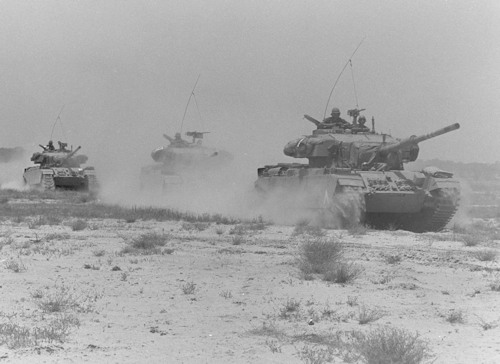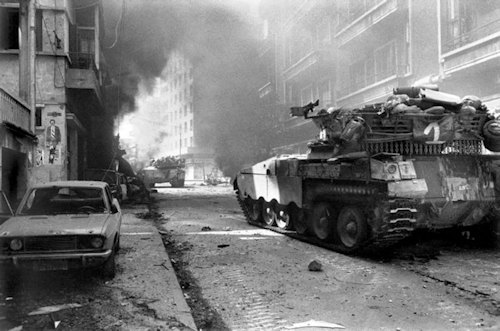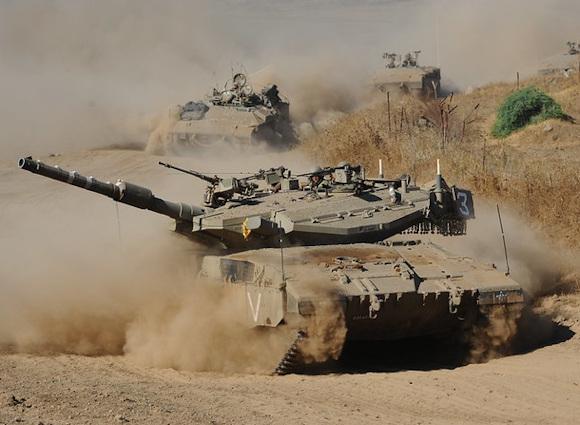The war in Ukraine has brought high-intensity operations back to the fore, where a high level of mechanization of the forces in the field is used and, among other things, a massive use of armored units.
The Russians, as per their doctrine, used the MBTs to break through the Ukrainian lines, however losing in large numbers due to anti-tank systems (medium and long range), artillery (single and multi-tube) and loitering munitions.
It could be argued that the time of heavy tanks, perhaps, is over, precisely because of the proliferation on the battlefield of varied weapon systems with continuously developing potential.
The wars of the past often provided lessons which were then put into practice in subsequent conflicts.
In the field of armored warfare, we believe that the conflicts of the second half of the 900th century in the Middle East, fought by the Israeli armored units, have provided important lessons in this regard.
The Israeli armored corps employed the heavy tank Centurion (with a mass of 52 t) in both the Six Day War (1967) and the Yom Kippur War (1973).
The tank Centurion it was developed by the British during the Second World War as a main battle tank (MBT) under the designation of A41. The first prototypes were ready in early 1945 and were armed with a 76 mm gun.
 The first troops who employed the Centurion on a large scale in a fight it was the Israelis who had acquired the tank from different countries, with enormous logistical problems. Despite the difficulties, during 1967, the Israelis managed to mount a more powerful engine (Teledyne Continental AVDS-1790-2A diesel) on the tank and to arm it with the 7/1 mm L105A52 rifled cannon.
The first troops who employed the Centurion on a large scale in a fight it was the Israelis who had acquired the tank from different countries, with enormous logistical problems. Despite the difficulties, during 1967, the Israelis managed to mount a more powerful engine (Teledyne Continental AVDS-1790-2A diesel) on the tank and to arm it with the 7/1 mm L105A52 rifled cannon.
La Six Day War it proved to be an excellent test bed for the use of armored forces when they have to face a numerically superior enemy. In the course of the campaign against Egypt, the Israeli army employed three main ones task forces battleships, equipped with tanks Centurion, M-48A2 Patton and some SuperSherman. These advanced rapidly against the outnumbered Egyptian armored forces and mainly with former Soviet T-34/85, S-3, T-54 and self-propelled Su-100 tanks.
Fortunately for the Israeli armored columns, many of the Egyptian tanks had been placed in fixed ("hedgehog") strongholds. This tactic completely sacrificed their ability to maneuver in the open and allowed the tanks with the star of david to quickly overtake them to penetrate to the rear. The task forces they managed to reach the important passes of Giddi and Mitla and close them. The Israeli tanks then continued their advance towards the Suez Canal: in six days it was all over.
On the northern front, on the other hand, the Israeli armored forces operated against the Syrian forces mainly on the Golan Heights and the surrounding highlands. There was little chance of carrying out the same type of action on the Sinai and most of the operations by tanks (mainly AMX-13 light tanks and Sherman) were of close support to the infantry. The whole campaign against the Syrians lasted 27 hours.
 On the Jordanian front, the activity of the Israeli armored forces remained limited to the level of the company, however little used in the short operation that led to the conquest of Jerusalem.
On the Jordanian front, the activity of the Israeli armored forces remained limited to the level of the company, however little used in the short operation that led to the conquest of Jerusalem.
In the Six Day War, the Israeli armored corps proved capable of locating and hitting enemy tanks at distances greater than 2.000 meters and were able to cope with both tanks damaged by enemy fire and those produced by long, high-speed routes across the desert.
But these were not the only reasons for the Israeli success in the Sinai campaign. They actually depended on the combination of high-speed maneuvering, close interarm cooperation, and a high degree of training of all IDF soldiers. All the more astonishing is the fact that they were staff composed for the most part of reservists, who passed directly from their homes and workplaces to combat posts.
In 1973 the Yom Kippur War.
This time the Israelis were taken by surprise as large Egyptian forces crossed the Channel and the Syrians to the north descended from the Golan Heights. In Sinai, many desperate counterattacks, often with the use of Centurion, were launched at the Egyptian troops, but the Israeli tanks soon collided with the wire-guided missiles, supplied to the Egyptians by the Soviets, AT-3 sagger, with which they destroyed several Centurion.

As more troops and other chariots poured into the battle area, such costly counterattacks soon increased in cohesion and strike force. However, once the main Egyptian effort was exhausted, the Israelis took the lead by crossing the Suez Canal before the ceasefire went into effect.
In the north, the battle against the Syrians had even more epic characteristics.
The Damascus forces had launched a preordained armored vehicle attack on a massive scale against unprepared and poorly armed Israeli units. Thousands of Syrian T-54s and T-55s advanced in phalanx formation against Israeli positions, where only a few tanks, including some Centurion, they were waiting for them: having no possibility of retreating, the Israelis had no choice but to hold their positions at any cost. Taking advantage of the support of artillery and air force, the Israeli soldiers moved from one point to another, continuing to fire on the enemy who, massed together, seemed unable to operate autonomously once the initial attack was launched. Singles Centurion they were able to locate and hit the enemy vehicles one by one, to the point that the areas in front of the Israeli lines resembled cemeteries of wagons.
The Israelis suffered heavy losses, both in men and in means, but they resisted long enough, until the reserves arrived that guaranteed the victorious outcome of the battle. With the fighting over, the Israelis had gained superiority on both main fronts.
 At the end of the Yom Kippur War, the Israeli armored corps had suffered heavy losses, both in terms of crews and tanks. Although it was later provided to equip the Centurion and the M-60s of additional protections to counter the effects of the hollow charges of the counter-tank missiles, it was with the entry into service of the domestic production tank Merkava which allowed the Israelis a significant leap in quality in the field of armored warfare (the test took place in 1982 with thePeace in Galilee operation in Lebanon, where i Merkava - photo + opening photo - outclassed the Syrian T-72s).
At the end of the Yom Kippur War, the Israeli armored corps had suffered heavy losses, both in terms of crews and tanks. Although it was later provided to equip the Centurion and the M-60s of additional protections to counter the effects of the hollow charges of the counter-tank missiles, it was with the entry into service of the domestic production tank Merkava which allowed the Israelis a significant leap in quality in the field of armored warfare (the test took place in 1982 with thePeace in Galilee operation in Lebanon, where i Merkava - photo + opening photo - outclassed the Syrian T-72s).
The appearance on the battlefield of the ATGM (Anti-Tank Guided Missile) systems certainly had a strong impact on the survival chances of the MBTs then in service, however an attempt was made to improve passive protection (by mounting reactive plates, stratified armor, spaced etc) and, more recently, active defense systems.
Surely the usefulness of using heavy tanks, in future operational scenarios, will be at the center of upcoming discussions by military analysts. The introduction into service in the US Army, in the near future, of a new medium tank (with a mass equal to 36 t) will not retire the heavy tanks M-1A2 SEPv₃ (74 t).
However, we believe that MBTs may still have a role, even in contexts characterized by threats such as those seen on Ukrainian soil, provided they are used together with C-RAM assets.
The important thing is not to give in to the temptation of wanting to replace them with the so-called "rotated wagons" (as suggested by some defense lobbyists), that is heavy busways (29-30 t) equipped with armament equal to the MBTs (such as the Centaur II) but that in terms of survival capacity, in a conflict like the Ukrainian one, they would not last even a minute.
Photo: IDF / Israel Government Press Office












